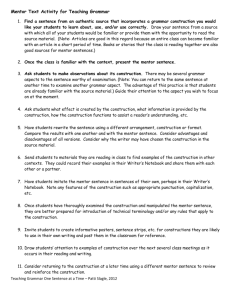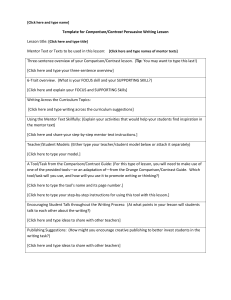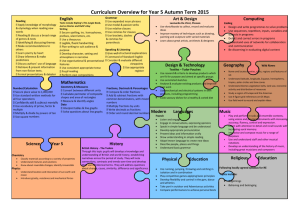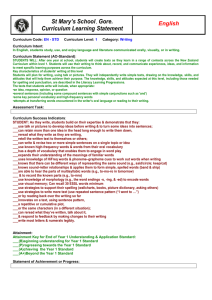Summer PD - Writing Deep Dive
advertisement
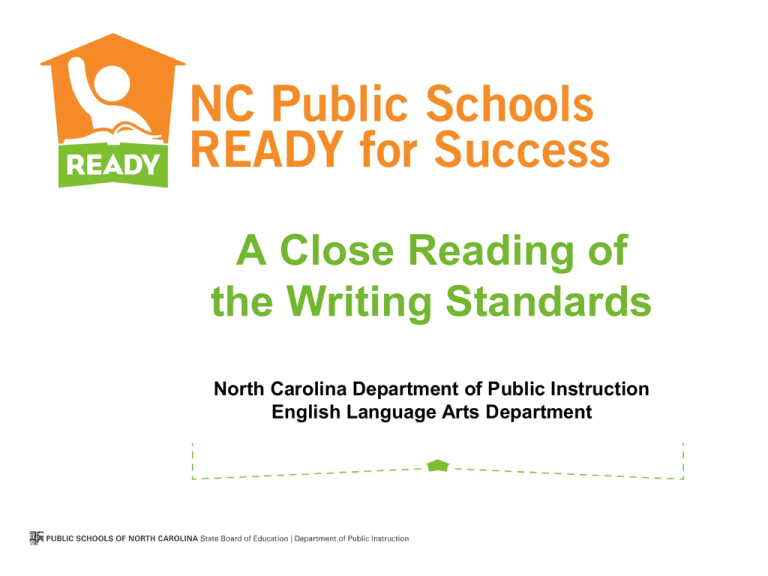
A Close Reading of the Writing Standards North Carolina Department of Public Instruction English Language Arts Department ELA PD Menu Resources ELA Professional Development Menu LiveBinder: http://tinyurl.com/od6rlnx ELA Professional Development Menu Wiki: http://tinyurl.com/mp5e9at Common Core and Writing Participants will understand the expectations of the Writing Standards. INTEGRATION of WRITING OVERVIEW Language Reading Writing Speaking and Listening Agreements Ask questions. Engage fully. Integrate new information. Open your mind to diverse views. Utilize what you learn. Participants as Writers • Participant’s Notes • Do a Quick Write about “your first memory of writing.” Nobody but a reader ever became a writer. - Richard Peck Writing to Read In the Writing to Read report, Graham and Hebert examine whether various approaches to writing instruction impact students’ reading skills and comprehension. The report: • describes a range of instructional practices that have demonstrated a positive effect on reading outcomes. • provides guidance on how teachers can use writing instruction to strengthen students’ reading performance. Graham, S., & Hebert, M.A. (2010). Recommendation #1 Have students write about text they read. Writing to Read: Evidence for How Writing Can Improve Reading Research to build and present knowledge Writing Standards 7, 8 and 9 Having students respond to a text… improves reading comprehension. • Writing personal reactions • Analyzing the Text Writing to Read: Evidence for How Writing Can Improve Reading Having students write summaries of a text… has a positive impact on reading comprehension. Writing summaries: •using only one sentence •using a set of rules or steps •using an outline •by locating and using the main idea in each paragraph •using graphic organizers Writing to Read: Evidence for How Writing Can Improve Reading Having students write notes about a text… enhances comprehension. “Taking notes about text proved to be better than just reading, reading and rereading, reading and studying, reading and underlining important information, and receiving explicit instruction in reading practice.” Writing to Read: Evidence for How Writing Can Improve Reading Having students answer questions about a text in writing or create and answer written questions about a text… shows greater benefit than answering questions about a text verbally. • Answering questions about a text in writing; • Writing questions about text read; • Learning how to locate main idea in a text, generating and answering their own questions about text. Writing to Read: Evidence for How Writing Can Improve Reading Recommendation #2 Teach students the writing skills and processes that go into creating text. Writing to Read: Evidence for How Writing Can Improve Reading Production and Distribution of Writing Writing Standards 4, 5, and 6 Teaching students the process of writing, text structures for writing, paragraph or sentence construction skills… improves reading comprehension. Two effective strategies were: the process approach to writing explicit instruction/mini-lessons that focused on spelling, sentence combining, and multiparagraph composition were beneficial. Writing to Read: Evidence for How Writing Can Improve Reading Teaching students sentence construction… improves fluency. Activities in the study focused on the formation of complex sentences from smaller units of writing. This type of writing instruction improved reading fluency for students in grades 1-7. Writing to Read: Evidence for How Writing Can Improve Reading Teaching students spelling… improves word reading skills. Activities in the study focused on the spelling patterns of letters and sounds in words. Writing to Read: Evidence for How Writing Can Improve Reading Recommendation #3 Increase how much students write. Writing to Read: Evidence for How Writing Can Improve Reading Range of Writing Writing Standard 10 Increasing how much students write… improves reading comprehension. Effective instructional practices in this category included both independent and collaborative writing opportunities. Writing to Read: Evidence for How Writing Can Improve Reading Supporting Young Writers All of the skills that are essential for college and career readiness in high school have their beginnings in the primary grades. Text Types In the K-2 classroom, create a classroom environment where students: • know they are authors • express their opinions • share what they know about a topic • recount an event (Writing Standards 1-3) Process Writing In the K-2 classroom, adults guide and support young authors as they learn to strengthen their writing by: • responding to questions and suggestions from peers • add details • focus on a topic (Writing Standard 5) Grammar in Context In the K-2 classroom, students learn: • grammar and usage in context (shared reading) • to try it out (demonstrate command) in their own writing through models (shared writing) (Language Standards 1-2 and Language Standard 3 in grade 2.) Using Digital Tools In the K-2 classroom, with guidance and support from adults, students use digital tools to: •produce writing •publish writing •collaborate with peers (Writing Standard 6) Shared Research Projects In the K-2 classroom, students participate in shared research and writing projects. These shared research projects include author studies, “how to” books, studying a topic, and recording science observations. (Writing Standards 7 and 8) The Writing Standards Review of the Writing Standards 1-3 ① Argument ② Informational/Explanatory ③ Narrative Three Text Types What does Appendix A tell us about the text types? In the descriptions look for: oPurpose oDefinition oHow http://www.corestandards.org/assets/Appendix_A.pdf p. 23-25 The Power of Metaphors Metaphors are essential because they help us understand and explain big ideas. Create a Metaphor Choose a text type and create a metaphor that gets to the heart of that type of writing… Narratives are tapestries, each thread is an experience in our lives. Combining the Text Types • Skilled writers many times use a blend of these three text types to accomplish their purpose… (from Appendix A) The Emphasis on Argument • While all three text types are important, the Standards put particular emphasis on students’ ability to write sound argument on substantive topics and issues, as this ability is critical to college and career readiness. p.24 Appendix A • It’s important to teach all types Persuasion or Argument? According to Appendix A of the CCSS: persuasive writing might “appeal to the audience’s self-interest, sense of identity, or emotions,” whereas a logical argument convinces the audience because of the perceived merit and reasonableness of the claims and proofs offered rather than either the emotions the writing evokes in the audience or the character or credentials of the writer” (p. 24). From: 5 Things Every Teacher Should be Doing to Meet the Common Core State Standards, Eye on Education http://www.eyeoneducation.com/bookstore/client/client_ pages/pdfs/5ThingsCCSS_Davis.pdf Narration as Knowledge • “My experience is what I know”. • Writing from the inside out William Strong, Write for Insight Narrative Perks • Fosters understanding – “Our lives intersect through shared stories” – I can relate to that… • Inspires – generates ideas for writing and thinking. Create thinking logs for future research. • Connects – Discover meaning in their own experiences and connect to curriculum content. From Narrative to Informational Participants gather in groups of 4. In your group, talk about the first time you felt like a writer. Write it as a paragraph on the blank side of your card. Now, line up according to the grade-specific time you felt like a writer. Tell your story in your grade-specific time line group. Go back to your original group and answer the questions on the back of the card. Questions To move from narrative to informational: What did the experience teach you? How did this experience help shape who you are as a writer today? How does this experience relate to other stories in your learning history? We are the stories we tell. • Connect new and confusing experiences to old stories – actively seeking to make sense – to figure out and make a new story. • Narrative can help students negotiate the thinking challenges posed by informative, practical writing and argument. It’s about balance! • And it is about building skills • And it is about scaffolding understanding • And it is about integration of text types Examining the Progression of the Writing Standards • Find the document titled: “Common Core State Standards for Writing” • Look at the first writing standard • Using a pen/pencil/highlighter move from grade to grade underlining what is different from the previous grade What did you observe? Consider: o K-2 o 3-5 o 6-8 o 9-12 At what grade do students move from opinion pieces to argument? What is the biggest difference when comparing 8th to 9-10th? When are students expected to provide a conclusion? http://rt3nc.org/objects/standards/cclitmap/ela.html Break Time Review of the Writing Standards 4 - 10 ④ Developing and organizing according to task, purpose, and audience ⑤ Revising, editing, rewriting to strengthen writing ⑥ Using technology to produce, publish, and collaborate ⑦ Completing short and long research projects ⑧ Gathering, assessing, and integrating information from multiple sources ⑨ Drawing evidence from texts to support analysis ⑩ Writing routinely for a range of tasks, purposes, and audiences Writing Standards Haiku • Work with a partner • Choose one Writing Anchor Standard from 4-10 • Create a haiku that expresses the gist of that standard Haiku: 5-7-5 syllables Example of Haiku Develop writing Plan, revise, edit, rewrite Try a new approach. Anchor Standard 5 Anchor Standard 4 • Produce clear and coherent writing in which the development, organization, and style are appropriate to task, purpose, and audience. Supporting this standard: • Read Like a Writer • Using Mentor Texts Read Like a Writer What does it mean? • Read to identify the choices the author made so you can better understand how these choices might arise in your own writing. • Reading to learn about writing “Ideal readers do not follow a story: they partake of it.” Alberto Manguel from A Reader on Reading, 2010. When you read like a writer you notice: • Word choice • Sentence structure • Organization • And…… What questions would you ask as a writer? When you read like a writer: Annotate and Read Closely • Read with a pen or highlighter in hand • Make comments in the margins • Write yourself notes and summaries • Look for patterns Underline and highlight the passage in the text itself and ask yourself: What is the technique the author is using here? Is this technique effective? What would be the advantages and disadvantages if I tried this same technique in my own writing? “This I Believe” View “This I Believe Video” http://tinyurl.com/czh978c Lunch Time! Using Mentor Texts “The simple rhythm of copying someone else’s words gets us into the rhythm of writing, then you begin to feel your own words.” -William Forrester, Finding Forrester Steal Like an Artist “Nobody is born with a style or a voice. We don’t come out of the womb knowing who we are. In the beginning, we learn by pretending to be our heroes. We learn by copying. We’re talking about practice here, not plagiarism – plagiarism is trying to pass someone else’s work off as your own. Copying is about reverseengineering. It’s like a mechanic taking apart a car to see how it works.” -Steal Like an Artist by Austin Kleon What are Mentor Texts? A mentor text is any piece of writing that can be used to teach a writer about some aspect of writer’s craft. The best mentor texts are those that can be used numerous times throughout the school year to demonstrate many different characteristics of a text. (ideas, structure, written craft) Steps to Using Mentor Texts Select a text to emulate and reread – one that inspires a new idea, structure, or craft worth trying. Read it (Read like a reader) Analyze it (Read like a writer) Emulate it (Write like the writer) - adapted from Kelly Gallagher Let’s Practice! Choose one of the following ways to prompt your writing. Borrow any line or word from the text that inspires you to write. Look at the last sentence, write 4 more sentences. Choose a section of the text that inspires you to write using that technique (i.e. author’s writing style, use of language, or sentence structure) Look at Grade Specific Standards • Read Standard 4 for your grade and consider the two strategies just discussed. • Read Like a Writer • Using Mentor texts • Record your ideas and/or insights. Mentor Text Resources Creating Successful Writers with Mentor Texts http://www.reading.org/downloads/53rd_conv_handouts/mentor_texts_cappelli_dorfman. pdf Mentor Text for the Traits of Writing http://www.scholastic.com/teachers/article/mentor-texts-traits-writing Teacher 2 Teacher – What are mentor texts? http://www.teacher2teacherhelp.com/writing-strategies/what-are-mentor-texts/ How to Use Mentor Text to Teach Writing http://www.ehow.com/how_8216119_usementor-texts-teach-writing.html Anchor Standard 5 • Develop and strengthen writing as needed by planning, revising, editing, rewriting, or trying a new approach. Supporting the standard with: • Grammar instruction • Integrating Language standards Grammar Research and Evidence •Teaching in the context of writing •Focus on sentence combining Model and Practice •Using a Mentor Text •Online Tools Integration of the Standards - Writing and Language Grammar to Enrich and Enhance Writing by Constance Weaver (2008) Why teach grammar in context? • Connection to outcomes in standards: Writing Standard 5: Develop and strengthen writing as needed by planning, revising, editing, rewriting, or trying a new approach Language Standards 1-3: Producing, expanding, and rearranging complete, simple, and compound sentences is an expectation as early as grade 2, Language Standard 1f. • Research and evidence based: “Isolated grammar instruction appears to have little or no positive impact in helping poor writers become better writers” (Graham & Perin, 2007). Teaching Sentence Combining… • Improves fluency and comprehension (Writing to Read: Evidence for How Writing Can Improve Reading, A Carnegie Corporation Time to Act Report, 2010) • Is a promising method of teaching grammar in context http://tinyurl.com/bck4bts (Graham & Perin, 2007; Strong, 1986) Teaching sentence combining… 1. Analyze the use of punctuation and sentence types in a mentor text. 2. Practice combining sentences with guidance (guided practice) 3. Analyze sentences in their own writing. 4. Practice combining sentences in their own writing with guidance and support from peers and adults (try a new approach). http://www.youtube.com /watch?v=4AyjKgz9tKg Step 1: Using Mentor Text to Teach Grammar in Context Reread Joe Willhoft’s essay: This I Believe Take note of the following – highlight or circle: 1. The use of punctuation to combine sentences and phrases 2. Use of different types of sentences (simple, compound, complex) Step 2: Let’s Practice! About.com Grammar and Composition: http://tinyurl.com/ap7naea Purdue Online Writing Lab: http://tinyurl.com/a8bxu2m Important Next Steps! Step 3 : Analyze your own writing • Teach sentence combining using the process approach to writing. • Return to your first memory of writing piece for this activity. – Note and annotate how you used punctuation for effect and to combine sentences in your response. – Note and annotate the different types of sentences you wrote Step 4: Try it in your own writing • Revise and try a new approach by using a strategy for combining sentences. Integration of Writing/Language Standards for Sentence Combining Beginning in grade 3, Writing Standard 5: (Develop and strengthen writing as needed by planning, revising, editing, rewriting, or trying a new approach) is integrated with and references Language Standards 1, 2, and 3. Language Standard 1 – produce and expand sentences L.K.1f Language Standard 2 – use of punctuation in combining sentences L.1.1g-j L.4.2c L.2.1f L.5.2b-c L.3.1h-I L.6.2a L.4.1a-f L.7.2a L.5.1a-b L.8.2a-b L.7.1b-c L.9-10.2a-b L.9-10.1a-b L.11-12.2a Language Standard 3 – choose words and phrases and vary sentences L.3.3a L.4.3a-b L.5.3a L.6.3a L.7.3 L.11-12.3.a Look at Grade Specific Standards • Read Standard 5 for your grade and consider the two strategies just discussed. • Sentence Combining • Using mentor texts to teach grammar in context • Record ideas and/or insights. Anchor Standard 6 • Use technology, including the internet, to produce and publish writing and to interact and collaborate with others. Supporting the standard with: • Resources • Using the internet to collaborate Meet and Exchange Introduce yourself to 3 people you don’t work with and are not at your table. Share your online resource and how it can be used to support instructional delivery of Writing Standard 6. Look at Grade Specific Standards • Read Standard 6 for your grade and consider the resources and technology tools explored. • Record ideas and/or insights. Break Time Anchors 7,8, and 9 W.CCR.7: Conduct short as well as more sustained research projects based on focused questions, demonstrating understanding of the subject under investigation. W.CCR.8: Gather relevant information from multiple print and digital sources, assess the credibility and accuracy of each source, and integrate the information while avoiding plagiarism. W.CCR.9: Draw evidence from literary or informational texts to support analysis, reflection, and research. Supporting these standards • Research projects • Note taking • Evidence Sample Research Strategies Saturation Reports Personalized Research Paper Multi-genre Research Taking Notes: • Teaching students to gather credible information to support their research • Resource: Energize Research Reading and Writing by C. Lehman Teach Students to Rely on Understanding, Not Tricks to Hold onto Large Concepts Focus first on comprehension/main idea. To do this…have students practice visualizing information, then use visual images to uncover main idea. Slow and Steady Wins the Race: Teach Students to Paraphrase Well by Pausing to Think Students pause to reflect on their reading before jotting down notes. To do this… have students read a section, cover it up and jot down notes about their learning. Go back and reread the same section, looking for details or domain-specific vocabulary they need. You Say Tomato, I Say Heirloom Jubilee Tomato Cultivar: Teach Students to Notice Variation and Gradation in Domain-Specific Vocabulary Teach students to pay attention to the variety of terms used to describe similar ideas or concepts as they read across texts. To do this…pay attention to how ideas and concepts are described across sources. • keep a word list • Then, simply look the word up, or reread texts that the terms came from Resources for Note Taking Elementary: • Readwritethink Fact Fragment Frenzy http://www.readwritethink.org/files/resources/interactives/factfrenzy/opening.html • Readwritethink Notetaker http://www.readwritethink.org/classroom-resources/studentinteractives/readwritethink-notetaker-30055.html Elementary-Secondary: • Readwritethink Outline Tool http://interactives.mped.org/view_interactive.aspx?id=722&title • “Notemaking” using Graphic Organizers http://www.englishcompanion.com/Tools/notemaking.html • Incredible Shrinking Notes http://www.educationworld.com/a_lesson/03/lp322-02.shtml • Take Note: Five Lessons for Note Taking Fun http://www.educationworld.com/a_lesson/lesson/lesson322.shtml “Give your evidence,” said the King; “and don’t be nervous, or I’ll have you executed on the spot.” Alice in Wonderland, Chapter 11. Evidence Let’s find evidence in the standards! color coding Click evidence to see where it occurs in the standards. Standard 9: Integrates the writing and reading standards by providing examples for both informational and literature that can be applied as students draw evidence from text. Evidence Resource • Intel Showing Evidence Tool http://www.intel.com/content/www/us/en/educ ation/k12/thinking-tools/showing-evidence/trythe-tool.html Look at Grade Specific Standards • Read Standards 7, 8, and 9 for your grade and consider the strategies just discussed. • Research projects • Note taking • Evidence • Record ideas and/or insights. Anchor Standard 10 • Write routinely over extended time frames (time for research, reflection, and revision) and shorter time frames (a single sitting or a day or two) for a range of tasks, purposes, and audiences. Supporting this standard: • Writing to Learn • Creating meaningful tasks Writing to Learn – Using writing as a tool for learning not only as a product of understanding! • For exploration (quick research, project notebook) • For thinking (graphic organizers, synthesis papers, summary writing) • For wondering (annotations, journals) Research on Summary Writing Writing Next Recommendation #2: Summarization, which involves explicitly and systematically teaching students how to summarize texts. Writing to Learn Recommendation #1: The teacher asks the students to write summaries and answer questions in writing to increase their ability to explain information, elaborate knowledge leading to deeper understanding… How to Write a Summary 1) Identify or select the main information; 2) Delete trivial information; 3) Delete reluctant information; and 4) Write a short synopsis of the main and supporting information for each paragraph. Rinehart, Stahl, and Erickson (1996) Creating Meaningful Writing Tasks CRAFT is an effective tool for creating writing tasks. Context Role Audience CRAFT is a strategy teachers can use across disciplines to address task purpose and audience. Format Topic The Writing Task: Sample CRAFT The Great Gatsby “Does History Repeat Itself?” Recent concern over the “fiscal cliff” has caused many people to question their quality of living. Imagine you are an editor for the New York Times in New York City and you have researched the Great Depression and our current state of the economy. Write an editorial for the public describing how history repeats itself. Creating Meaningful Writing Tasks Online Writing Instruction System OWI on NC Education includes writing templates aligned to the Writing Standards https://center.ncsu.edu/nc/ Creating Meaningful Writing Tasks Writing task templates were created by the Literacy Design Collaborative. They include task templates, examples, and rubrics. You can find them at: Elementary Writing Tasks Secondary Writing Tasks Look at Grade Specific Standards • Read Standard 10 for your grade and consider the strategies just discussed. • Writing to Learn • Creating meaningful tasks • Record ideas and/or insights. Appendix B: Text exemplars and sample performance tasks. Appendix C: Annotated student writing samples for grades K-12. Reflection… Directions: Contact Information Julie Joslin, Ed.D. Section Chief English Language Arts 919-807-3935 Julie.Joslin@dpi.nc.gov Kristi Day, M.Ed K-5 ELA Consultant 919-807-3928 Kristi.Day@dpi.nc.gov Lisa McIntosh, MSA K-5 ELA Consultant 919-807-3895 Lisa.Llewellyn@dpi.nc.gov Anna Lea Frost, M.Ed 6-8 ELA Consultant 919-807-3952 Anna.Frost@dpi.nc.gov Angie Stephenson, M.Ed 9-12 ELA Consultant 919-807- 3833 Angela.Stephenson@dpi.nc.gov
